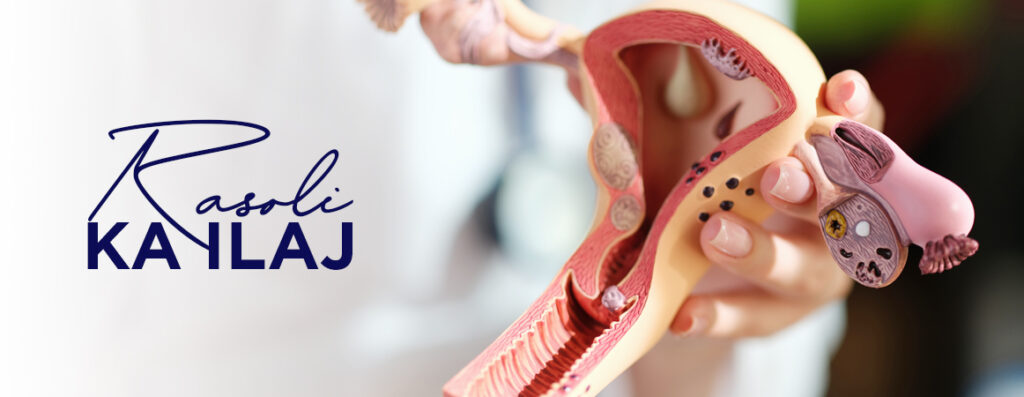Rasoli ka Ilaj
What Are Rasoli?
Rasoli in uterus are benign tumors that arise from the smooth muscle tissue of the uterus. These growths range in size from pea-sized to melon-sized, with wide variations. In some cases, women may have just one fibroid, while others may develop multiple fibroids at once.
Fibroids are categorized according to where they are located in the uterus:
- Intramural fibroids: These are the most prevalent variety and develop inside the uterine muscle wall.
- Submucosal fibroids: These fibroids develop just beneath the lining of the uterine cavity and can protrude into the uterus, sometimes causing heavy menstrual bleeding.
- Subserosal fibroids: These are external growths on the uterus that might cause discomfort by pressing on nearby organs.
Rasoli Causes: What Leads to Their Development?
The exact causes of fibroids in the uterus are not fully understood, but several factors are believed to contribute to their development:
- Hormonal Imbalances: Estrogen and progesterone, the hormones that regulate the menstrual cycle, appear to promote the growth of fibroids. As hormone levels drop after menopause, fibroids often decrease.
- Genetic Factors: Women with a family history of fibroids are more likely to develop them, suggesting a genetic predisposition.
- Age and Reproductive History: Fibroids are more common in women in their 30s and 40s, especially those who have never been pregnant.
- Lifestyle Factors: Obesity, high blood pressure, and a diet high in red meat and low in green vegetables have been linked to an increased risk of fibroids.
Recognizing Rasoli Symptoms
Many women who have uterine fibroids don’t even know they have them; instead, they are frequently found during routine imaging or pelvic exams. However, when symptoms do occur, they can vary widely depending on the size, number, and location of the fibroids. Common fibroids symptoms include:
- Heavy Menstrual Bleeding: Excessive menstrual bleeding is one of the most typical signs of rasoli, and it can cause anemia.
- Pelvic Pain or Pressure: Women with large or numerous fibroids may experience a feeling of fullness or pressure in the pelvic area, sometimes accompanied by pain.
- Frequent Urination: Subserosal fibroids that press against the bladder can cause frequent urination or difficulty emptying the bladder.
- Pain During Intercourse: Rasoli located near the cervix or within the uterine cavity can make intercourse painful.
- Constipation: If fibroids press on the rectum, they can cause constipation or other bowel issues.
Rasoli Ka Ilaj: Managing the Condition
Rasoli treatment depends on the severity of symptoms, the size and location of the fibroids, and the woman’s overall health and reproductive goals. Here are some common rasoli treatment options:
1. Watchful Waiting
For women with small fibroids that cause no symptoms, a watchful waiting approach may be recommended. This involves regular monitoring of the fibroids through pelvic exams and ultrasounds to ensure they are not growing or causing complications.
2. Medications
Medications can help manage rasoli symptoms but do not eliminate them. Hormonal treatments, such as birth control pills or gonadotropin-releasing hormone (GnRH) agonists, can help regulate menstrual cycles and reduce heavy bleeding. Non-hormonal medications, like anti-inflammatory drugs, may be used to relieve pain.
3. Minimally Invasive Procedures
Several minimally invasive procedures are available to treat fibroids in the uterus:
- Uterine Fibroid Embolization (UFE): This procedure involves injecting tiny particles into the arteries supplying the fibroids, cutting off their blood supply and causing them to shrink.
- Endometrial Ablation: This treatment destroys the lining of the uterus, reducing heavy menstrual bleeding associated with fibroids.
- Myomectomy: This surgical procedure removes the fibroids while preserving the uterus, making it a good option for women who wish to retain fertility.
4. Surgical Options
For larger fibroids or severe symptoms, more invasive surgical options may be necessary:
- Hysterectomy: The only permanent treatment for rasoli is uterus removal. It is typically recommended for women who have completed childbearing or have severe symptoms.
- Laparoscopic or Robotic Myomectomy: These less invasive surgeries remove fibroids through small incisions, reducing recovery time and preserving the uterus.
Conclusion
Understanding rasoli causes, recognizing rasoli symptoms, and exploring the various rasoli treatment options are crucial for managing this condition effectively.
Post Disclaimer
The information contained in this post is for general information purposes only. The information is provided by "Rasoli ka Ilaj "and while we endeavour to keep the information up to date.
Legal Disclaimer
We do not claim to cure any disease which is considered’ incurable ‘ on the basis of scientific facts by modern medicine .The website’s content is not a substitute for direct, personal, professional medical care and diagnosis. None of the medicines mentioned in the posts ,including services mentioned at "medicineguide.us" should be used without clearance from your physician or health care provider.
Testimonials Disclaimer– : Results may vary, and testimonials are not claimed to represent typical results. The testimonials are real, and these patients have been treated with homeopathy treatment from our clinic . However, these results are meant as a showcase of what the best, Medicine can do with their disease contions and should not be taken as average or typical results.


